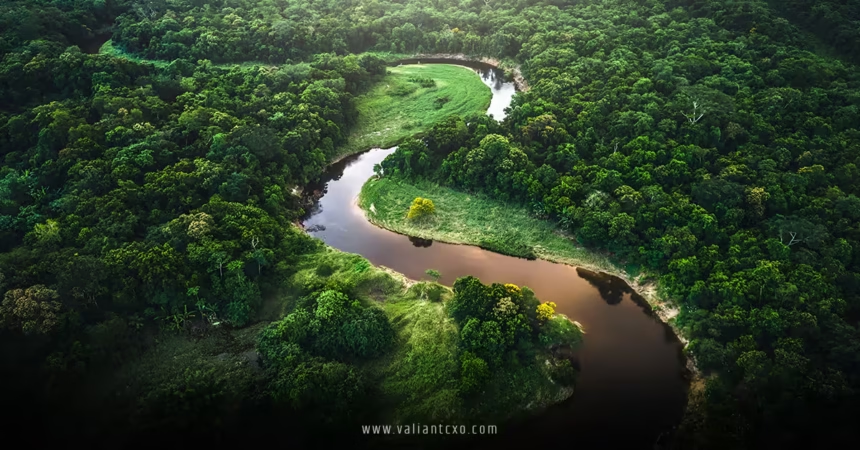Amazon rain forest is a marvel of nature, a sprawling green tapestry that blankets South America with life. Often called the “lungs of the Earth,” this vast ecosystem is more than just a forest—it’s a thriving, pulsating hub of biodiversity, culture, and climate regulation. Spanning over 5.5 million square kilometers across nine countries, the Amazon rain forest is a treasure trove of natural wonders. But why does it matter so much? And what makes it so unique? Let’s dive into the heart of this jungle and uncover its secrets, its challenges, and why we should all care about its future.
What Makes the Amazon Rain Forest So Special?
Picture a place so vibrant that every step reveals a new creature, plant, or sound. That’s the Amazon rain forest. It’s home to an estimated 400 billion individual trees from 16,000 species, and that’s just the start. From jaguars prowling silently to neon-colored frogs smaller than your thumbnail, the Amazon rain forest hosts an unmatched variety of life. Scientists estimate that it contains 10% of the world’s known species, many of which are found nowhere else.
But it’s not just about the numbers. The Amazon rain forest feels alive, like a symphony where every leaf, bug, and bird plays a part. Walking through it (if you’re lucky enough to visit) is like stepping into a living, breathing painting—one that’s been evolving for millions of years. It’s no wonder researchers and adventurers are drawn to its mysteries, from undiscovered plants to indigenous tribes who’ve called it home for millennia.
A Biodiversity Hotspot Like No Other
The Amazon rain forest is a biodiversity superstar. It’s home to over 2.5 million insect species, 40,000 plant species, 2,200 fish species, and hundreds of mammals, birds, and reptiles. Ever heard of the pink river dolphin? Or the glass frog, with its see-through skin? These are just a couple of the quirky residents of the Amazon rain forest. This diversity isn’t just cool to think about—it’s critical. Many plants here have medicinal properties, with some estimates suggesting 25% of modern medicines come from rain forest plants. That headache pill you popped last week? It might owe a nod to the Amazon.
But this biodiversity is fragile. Every time a section of the Amazon rain forest is cleared, we risk losing species forever—some we may never even discover. It’s like burning a library before reading all the books. Protecting this biodiversity isn’t just about saving cute animals; it’s about preserving a natural pharmacy and a genetic treasure chest for future generations.
The Amazon Rain Forest’s Role in the Global Ecosystem
The Amazon rain forest isn’t just a local wonder—it’s a global MVP. Its trees act like giant sponges, soaking up carbon dioxide and pumping out oxygen. In fact, the Amazon rain forest produces about 20% of the world’s oxygen, earning its “lungs of the Earth” nickname. But it’s not just about air. The forest plays a massive role in regulating the planet’s climate by absorbing greenhouse gases and stabilizing rainfall patterns.
Ever wonder how a forest in South America affects your weather? The Amazon rain forest creates “flying rivers”—massive streams of water vapor that travel thousands of miles, influencing rainfall as far away as North America and Europe. Without the Amazon, global weather patterns could go haywire, leading to droughts, floods, and all sorts of chaos. It’s like the Amazon rain forest is the planet’s thermostat, keeping things balanced.
Water, Carbon, and Climate: The Amazon’s Superpowers
The Amazon rain forest is a master at multitasking. Its rivers, including the mighty Amazon River, carry more water than any other river system on Earth. These waterways support life far beyond the forest’s borders, feeding agriculture and communities across the continent. Meanwhile, the forest’s trees store billions of tons of carbon, acting as a buffer against climate change. But when those trees are cut down or burned, that stored carbon is released, speeding up global warming. It’s a vicious cycle—lose the forest, lose the balance.
This makes the Amazon rain forest a critical player in the fight against climate change. Protecting it isn’t just about saving trees; it’s about keeping our planet livable. Imagine the Amazon as a superhero, quietly saving the day while we go about our lives. But even superheroes need help sometimes.
The People of the Amazon Rain Forest
The Amazon rain forest isn’t just about plants and animals—it’s home to millions of people, including over 400 indigenous groups. These communities have lived in harmony with the forest for thousands of years, relying on its resources for food, shelter, and medicine. Their knowledge of the Amazon rain forest is mind-blowing, from knowing which plants heal wounds to navigating rivers that seem impossible to cross.
But these communities face challenges. Deforestation, mining, and land grabs threaten their way of life. For many indigenous groups, the Amazon rain forest isn’t just a home—it’s their identity, their history, their everything. When we talk about saving the Amazon, we’re also talking about protecting these cultures and their wisdom. Isn’t it humbling to think that people have thrived in such a wild place for so long?
Indigenous Wisdom and Modern Challenges
Indigenous peoples are the Amazon rain forest’s original stewards. They’ve mastered sustainable practices, like agroforestry and selective hunting, that keep the ecosystem thriving. Modern conservation efforts could learn a lot from them. But today, many of these communities are fighting to protect their land from outsiders—loggers, miners, and agribusinesses—who see the Amazon rain forest as a resource to exploit.
Supporting indigenous rights isn’t just a moral issue; it’s practical. Studies show that forests managed by indigenous communities are often better preserved than those under government or private control. It’s like trusting the people who’ve lived in a house for generations to know how to maintain it best.
Threats Facing the Amazon Rain Forest
The Amazon rain forest is under siege. Deforestation is the biggest threat, with vast swaths cleared for cattle ranching, soy farming, and mining. Since the 1970s, about 20% of the Amazon rain forest has been lost—an area larger than France. That’s not just a number; it’s a tragedy. Every felled tree means fewer habitats, more carbon in the atmosphere, and a weaker climate shield.
Illegal logging and fires are also major issues. In 2019, images of the Amazon rain forest burning shocked the world, with flames tearing through ecosystems that took centuries to form. Climate change itself is a threat, bringing droughts that make the forest more vulnerable to fires. It’s like the Amazon is caught in a perfect storm, and we’re all feeling the ripples.
Deforestation: A Ticking Time Bomb
Why is deforestation such a big deal? Beyond losing biodiversity, it disrupts the Amazon rain forest’s ability to regulate climate and water cycles. When trees are cut down, the soil erodes, rivers dry up, and local communities suffer. Plus, the carbon released from deforestation fuels global warming, which in turn makes the Amazon rain forest drier and more fire-prone. It’s a feedback loop that could push the forest past a tipping point, where it can’t recover.
Imagine the Amazon rain forest as a giant dam holding back climate chaos. Every tree cut is a crack in that dam. If it breaks, the consequences won’t just stay in South America—they’ll hit us all.
Conservation Efforts to Save the Amazon Rain Forest
The good news? People are fighting back. Governments, NGOs, and local communities are working to protect the Amazon rain forest. Brazil, which holds over 60% of the forest, has made strides in reducing deforestation rates in recent years, though progress is uneven. International organizations like the World Wildlife Fund (WWF) support conservation projects, from reforestation to sustainable development.
Technology is also a game-changer. Satellites monitor deforestation in real-time, helping authorities crack down on illegal activities. Meanwhile, initiatives like the Amazon Environmental Research Institute (IPAM) promote sustainable land use. It’s like giving the Amazon rain forest a high-tech shield and a team of dedicated guardians.
How You Can Help Protect the Amazon Rain Forest
Wondering how you can make a difference? Start small. Support sustainable products—like coffee or beef certified as “rain forest-friendly.” Reduce your carbon footprint by cutting energy use or eating less meat, since cattle ranching drives much of the Amazon rain forest’s destruction. Donate to organizations like Rainforest Foundation US, which empowers indigenous communities to protect their lands.
Every little bit helps. Think of it like adding a brick to a wall—the more we all contribute, the stronger the defense for the Amazon rain forest.
The Future of the Amazon Rain Forest
What lies ahead for the Amazon rain forest? It depends on us. If deforestation continues unchecked, scientists warn that the forest could reach a tipping point, turning into a savanna-like ecosystem. That would be catastrophic for biodiversity, indigenous peoples, and global climate. But there’s hope. Stronger policies, global cooperation, and public awareness can turn the tide.
The Amazon rain forest is resilient, but it’s not invincible. It’s up to us to give it a fighting chance. By supporting conservation, respecting indigenous rights, and making conscious choices, we can help ensure this incredible ecosystem thrives for generations.
Conclusion
The Amazon rain forest is more than a forest—it’s a lifeline for our planet. From its jaw-dropping biodiversity to its role in regulating climate, this ecosystem is irreplaceable. But it’s under threat, and saving it requires action from all of us—governments, communities, and individuals like you and me. By understanding the Amazon rain forest’s importance and supporting efforts to protect it, we can keep this green heart beating strong. So, what’s your next step? Let’s make sure the Amazon rain forest stays alive and thriving for generations to come.
FAQs About the Amazon Rain Forest
Why is the Amazon rain forest called the “lungs of the Earth”?
The Amazon rain forest earns this nickname because it produces about 20% of the world’s oxygen through photosynthesis and absorbs vast amounts of carbon dioxide, helping regulate the global climate.
How many species live in the Amazon rain forest?
The Amazon rain forest is home to an estimated 400 billion trees, 2.5 million insect species, 40,000 plant species, and thousands of animals, making it one of the most biodiverse places on Earth.
What is the biggest threat to the Amazon rain forest?
Deforestation, driven by cattle ranching, soy farming, and mining, is the primary threat, with about 20% of the Amazon rain forest already lost since the 1970s.
How do indigenous communities contribute to protecting the Amazon rain forest?
Indigenous groups use sustainable practices and traditional knowledge to manage the forest, often preserving it better than government or private efforts, as studies show.
What can I do to help save the Amazon rain forest?
You can support sustainable products, reduce your carbon footprint, and donate to organizations like the Rainforest Foundation that work to protect the Amazon rain forest.
Read More:valiantcxo.com


